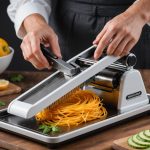Understanding Quick-Dry Fabrics
Quick-dry fabrics are revolutionising how we view kitchen towels. These fabrics, characterised by their ability to wick moisture and dry rapidly, are a game-changer. Their importance in kitchen environments cannot be understated. Kitchens are humid places where excess moisture can lead to unpleasant odours and bacteria accumulation. With quick-dry fabrics, that concern is significantly decreased.
The choice of fabric type matters greatly. Quick-dry fabrics generally fall into natural and synthetic categories. Natural quick-dry fabrics include those made from bamboo or cotton blends that offer a more organic approach. On the other hand, synthetic quick-dry options like polyester or microfiber are engineered for superior drying speed.
Additional reading : Unlocking Spice Harmony: The Ultimate Guide to Efficiently Organizing Your Spice Drawer
In the battle of natural versus synthetic, synthetic materials often win on drying efficiency and durability, while natural fabrics are valued for their absorbency and softer feel. Understanding these differences helps you choose the best option for your specific needs. A well-informed decision on fabric type can dramatically improve the sanitation and utility of your kitchen towels.
Benefits of Quick-Dry Fabrics for Kitchen Towels
Quick-dry fabrics for kitchen towels offer several important benefits that enhance their utility in kitchen environments. Their impressive absorbency allows them to soak up spills efficiently, reducing the amount of moisture that can lead to bacterial growth. This feature not only keeps your kitchen clean but also helps in maintaining hygiene by minimising odours often associated with damp towels.
In parallel : Discover the Top Juicer Designs for Effortless Cleaning
Additionally, the drying speed of these fabrics is noteworthy. Quick-dry materials significantly cut down on the time required for towels to be reusable, meaning fewer towels are needed in rotation. This can be particularly beneficial in busy kitchens where convenience and efficiency are priorities.
Moreover, these fabrics offer environmental benefits. High-performance quick-dry fabrics often require less energy for drying, making them an eco-friendly option for those conscious about their energy use. By reducing the drying time, these fabrics contribute to lower energy consumption and a smaller carbon footprint.
In summary, the benefits of quick-dry kitchen towels encompass enhanced absorbency, reduced bacteria and odours, and environmental advantages. Selecting the right quick-dry fabric can revolutionise kitchen towel performance, offering both practical and ecological solutions.
Comparing Different Fabric Materials
When examining fabric comparisons for kitchen towels, three standout options are microfiber, cotton, and polyester. Each has unique attributes that cater to different needs.
Microfiber
Microfiber is lauded for its superior absorbency and quick-drying nature. It captures even the smallest dust particles, making it ideal for spotless surfaces. It’s durable yet soft, though it may hold on to odours if not dried properly. Microfiber tends to be more expensive initially but saves money long-term due to its resilience.
Cotton
Known for natural absorbency, cotton offers a softer, plush feel that many prefer for everyday use. It’s great for soaking up liquids but takes longer to dry compared to synthetic options. In terms of pricing, cotton is generally affordable and widely accessible, appealing to budget-conscious consumers.
Polyester
Polyester offers excellent durability and drying speed. It withstands many washes without losing shape or colour, which is ideal for high-usage kitchens. However, it may not match cotton’s absorbency levels. The cost of polyester sits between microfiber and cotton, making it a versatile option that balances price and performance effectively.
Care Instructions for Quick-Dry Kitchen Towels
Proper care instructions are vital for maintaining the performance of quick-dry kitchen towels. To enhance their fabric maintenance, it’s crucial to follow specific laundry tips. Start by washing these towels separately from garments to prevent lint transfer. Use a mild detergent and avoid bleach, which can degrade the fabric.
When drying, steer clear of high heat settings. Instead, opt for a low or tumble setting to preserve the towel’s structure. Importantly, refrain from using fabric softeners; these can leave residues that affect absorbency.
Stain removal techniques require a gentle touch. Treat stains immediately using a mixture of water and vinegar. For tougher stains, a baking soda paste might do the trick. Always rinse thoroughly to ensure no cleaning residue remains. This meticulous approach ensures longevity and optimal performance of your kitchen towels.
When storing, ensure towels are completely dry to prevent mildew. A simple—but often overlooked—step is to hang them to air dry between uses. These techniques not only prolong towel life but also maintain the hygiene and efficiency of your kitchen workspace.
Factors to Consider When Choosing Quick-Dry Fabrics
When selecting quick-dry fabrics for kitchen towels, several key factors should be considered to ensure optimal performance and durability. Absorbency is crucial; it determines how effectively a towel can soak up spills and keep surfaces dry. Polyester and microfiber typically excel in this area due to their inherent moisture-wicking properties.
Durability is another important aspect, especially for high-use environments like kitchens. Fabrics that withstand frequent washing without deterioration, such as microfiber, are ideal for long-term use. Cotton, while naturally absorbent, may lose its shape over time but offers a softer feel that some prefer.
Finally, the importance of drying speed cannot be overstated. Faster drying reduces the risk of bacteria and mould, crucial for maintaining hygiene. Synthetic materials often outperform natural ones in this category. Considering these factors helps you make a well-informed decision, balancing absorbency, durability, and hygiene needs in your selection of kitchen towels.
Recommended Quick-Dry Kitchen Towels
When selecting the best quick-dry kitchen towels, exploring product recommendations can help you make an informed purchase. Certain high-performing brands specialise in producing durable and efficient towels that cater to various kitchen needs.
Top-rated Brands
Top-rated brands, like ‘Brand X’ and ‘Brand Y’, are renowned for their quick-dry capabilities. Products from these brands often showcase a blend of absorbency and robust construction, ensuring longevity even in demanding kitchen environments.
Features to Look For
When considering features, focus on absorbency, drying speed, and durability. Towels crafted from high-quality microfiber or polyester typically excel in these aspects, swiftly removing moisture and reducing bacteria growth. A strong, reinforced edge is also valuable, minimising fraying over time.
Budget-Friendly Options
For those conscious of cost, many viable budget-friendly options do not compromise on quality. Look for a balanced combination of natural and synthetic fibres. ‘Brand Z’, for instance, offers affordable quick-dry towels that combine attractive pricing with reliable performance. Engaging with trusted buying guides can result in finding the perfect towel that meets both functional and budgetary needs.










